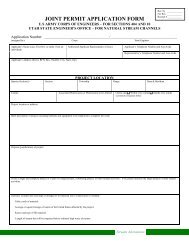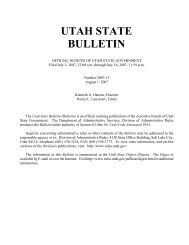Vol. 2010, No. 11 (06/01/2010) PDF - Administrative Rules - Utah.gov
Vol. 2010, No. 11 (06/01/2010) PDF - Administrative Rules - Utah.gov
Vol. 2010, No. 11 (06/01/2010) PDF - Administrative Rules - Utah.gov
Create successful ePaper yourself
Turn your PDF publications into a flip-book with our unique Google optimized e-Paper software.
NOTICES OF PROPOSED RULES DAR File <strong>No</strong>. 33631<br />
and competencies necessary for the level, scope and standards of<br />
nursing practice consistent with the level of licensure. The<br />
curriculum shall include:<br />
(a) content regarding legal and ethical issues, history and<br />
trends in nursing and health care, and professional responsibilities;<br />
(b) experiences that promote the development of<br />
leadership and management skills and professional socialization<br />
consistent with the level of licensure, including the demonstration<br />
of the ability to supervise others and provide leadership of the<br />
profession;<br />
(c) learning experiences and methods of instruction,<br />
including distance education methods, consistent with the written<br />
curriculum plan;<br />
(d) coursework including, but not limited to:<br />
(i) content in the biological, physical, social and<br />
behavioral sciences to provide a foundation for safe and effective<br />
nursing practice;<br />
(ii) didactic content integrated with supervised clinical<br />
experience in the prevention of illness and the promotion,<br />
restoration, and maintenance of health in patients across the life<br />
span and in a variety of clinical settings, to include:<br />
(A) using informatics to communicate, manage<br />
knowledge, mitigate error and support decision making;<br />
(B) employing evidence-based practice to integrate best<br />
research with clinical expertise and patient values for optimal care,<br />
including skills to identify and apply best practices to nursing care;<br />
(C) providing patient-centered, culturally competent care:<br />
(1) respecting patient differences, values, preferences and<br />
expressed needs;<br />
(2) involving patients in decision-making and care<br />
management;<br />
(3) coordinating and managing continuous patient care;<br />
and<br />
(4) promoting healthy lifestyles for patients and<br />
populations;<br />
(D) working in interdisciplinary teams to cooperate,<br />
collaborate, communicate and integrate patient care and health<br />
promotion; and<br />
(E) participating in quality improvement processes to<br />
measure patient outcomes, identify hazards and errors, and develop<br />
changes in processes of patient care;<br />
(e) supervised clinical practice which includes<br />
development of skill in making clinical judgments, management<br />
and care of groups of patients, experience with interdisciplinary<br />
teamwork, working with families in the provision of care, managing<br />
crisis situations, and delegation to and supervision of other health<br />
care providers:<br />
(i) clinical experience shall be comprised of sufficient<br />
hours, shifts, variety of populations, and hands-on practice to meet<br />
these standards, and ensure students' ability to practice at an entry<br />
level;<br />
(ii) no more than 25% of the clinical hours can be<br />
obtained in a nursing skills laboratory, or by clinical simulation or<br />
virtual clinical excursions;<br />
(iii) all student clinical experiences, including those with<br />
preceptors, shall be supervised by qualified nursing faculty at a<br />
ratio of not more than 10 students to one faculty member unless the<br />
experience includes students working with preceptors who can be<br />
supervised at a ratio of not more than 15 students to one faculty<br />
member; and<br />
(iv) nursing faculty, must be on-site with students during<br />
all fundamental, medical-surgical and acute care clinical<br />
experiences;<br />
(f)(i) clinical preceptors may be used to enhance facultydirected<br />
clinical learning experiences after a student has completed<br />
didactic and clinical instruction in all foundational courses<br />
including introduction to nursing, fundamentals, medical-surgical,<br />
obstetrics, and pediatrics. Therefore, clinical preceptors shall not be<br />
utilized in LPN nursing programs.<br />
(ii) a clinical preceptor shall:<br />
(A) demonstrate competencies related to the area of<br />
assigned clinical teaching responsibilities;<br />
(B) serve as a role model and educator to the student;<br />
(C) be licensed as a nurse at or above the level for which<br />
the student is preparing;<br />
(D) not be used to replace clinical faculty;<br />
(F) be provided with a written document defining the<br />
functions and responsibilities of the preceptor;<br />
(G) confer with the clinical faculty member and student<br />
for monitoring and evaluating learning experiences, but the clinical<br />
faculty member shall retain responsibility for student learning; and<br />
(H) not supervise more than two students during any one<br />
scheduled work time or shift; and<br />
(g) delivery of instruction by distance education methods<br />
must be consistent with the program curriculum plan and enable<br />
students to meet the goals, competencies and objectives of the<br />
educational program and standards of the [d]Division.<br />
(4) Students rights and responsibilities:<br />
(a) opportunities to acquire and demonstrate the<br />
knowledge, skills and abilities for safe and effective nursing<br />
practice, in theory and clinical experience with faculty oversight<br />
shall be provided to students;<br />
(b) all policies shall be written and available to students;<br />
(c) students shall be required to meet the health standards<br />
and criminal background checks as required in <strong>Utah</strong>;<br />
(d) students shall receive faculty instruction, advisement<br />
and oversight;<br />
(e) students shall maintain the integrity of their work;<br />
(f) (i) an applicant accepted into a nursing education<br />
program that has received provisional approval status from the<br />
Division, must sign a disclaimer form indicating the applicant's<br />
knowledge of the provisional approval status of the program, and<br />
the lack of a guarantee that the program will achieve national<br />
nursing accreditation and full approval status from the Division; and<br />
(ii) the disclaimer shall also contain a statement regarding<br />
the lack of a guarantee that the credit received from the<br />
provisionally approved program will be accepted by or transferable<br />
to another educational facility; and<br />
(g) an applicant accepted into a nursing education<br />
program or a student of a nursing education program that is on or<br />
receives probationary approval status from the Division, must sign a<br />
disclaimer form indicating the applicant or student has knowledge<br />
of the program's probationary approval status, and the lack of a<br />
guarantee that the program will maintain any approval status or will<br />
be able to offer the complete program.<br />
(5) An administrator of a nursing education program shall<br />
meet the following requirements:<br />
86 UTAH STATE BULLETIN, June <strong>01</strong>, <strong>2<strong>01</strong>0</strong>, <strong>Vol</strong>. <strong>2<strong>01</strong>0</strong>, <strong>No</strong>. <strong>11</strong>




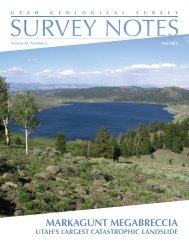
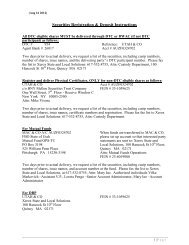
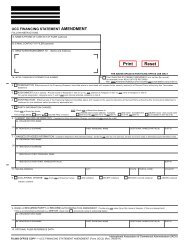
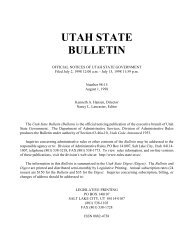
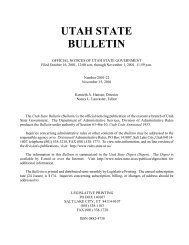



![Lynx avoidance [PDF] - Wisconsin Department of Natural Resources](https://img.yumpu.com/41279089/1/159x260/lynx-avoidance-pdf-wisconsin-department-of-natural-resources.jpg?quality=85)


